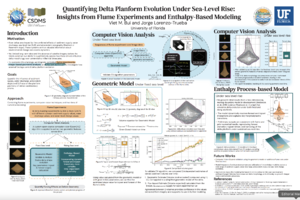2025 CSDMS meeting-122
(if you haven't already)
Log in (or create account for non-CSDMS members)
Forgot username? Search or email:CSDMSweb@colorado.edu
Browse abstracts
Quantifying Delta Planform Evolution Under Sea-Level Rise: Insights from Flume Experiments and Enthalpy-Based Modeling
We analyze 14 experimental runs conducted in a tilting flume facility that produced isolated fan deltas over a sloped, non-erodible basement. Each run maintained a fixed water-to-sediment discharge ratio and implemented a sea-level scenario—either constant, rising, or falling. These experiments span both steady base-level conditions with varying sediment and water inputs, and sea-level rise scenarios. To extract morphodynamic data, we apply a computer vision algorithm to time-lapse imagery, enabling automated reconstruction of topset and foreset geometries. Our first modeling approach uses a geometric framework that assumes conical fan delta shapes to estimate three-dimensional volumes and sediment partitioning between the subaerial topset and subaqueous foreset. The model quantifies key metrics (slope and opening angle), reveals a consistent relationship across scenarios between plan-view opening angle at the alluvial-bedrock transition and sediment/water discharge ratios: increasing sediment supply or decreasing water discharge produces narrower opening angles, and vice versa. The second model is a moving-boundary numerical framework based on the enthalpy method, enabling more realistic geometries and dynamic responses. Simulations under continuous sea-level rise replicate key experimental observations: foreset starvation leads to abandonment of the submarine delta front, while the topset migrates landward and narrows. This retreating geometric adjustment is effectively captured by the model. Its simplicity enables efficient exploration of a wide parameter space, providing new insights into deltaic evolution and sedimentary prism development under changing environmental conditions.
The integrated modeling framework provides a quantitative foundation for linking external forcings to delta morphology and stratigraphy. Our long-term goal is to apply this approach to constrain past sea-level histories and sediment budgets from plan view geometries, with future applications to Arctic deltas and other climate-sensitive coastal systems.

